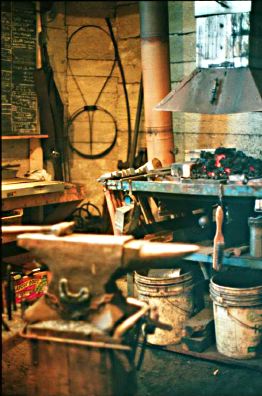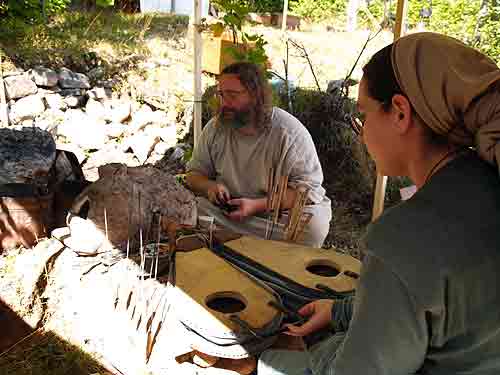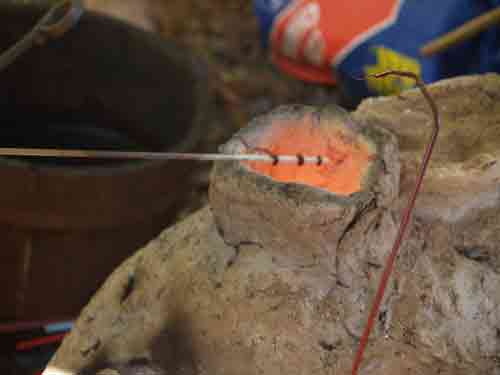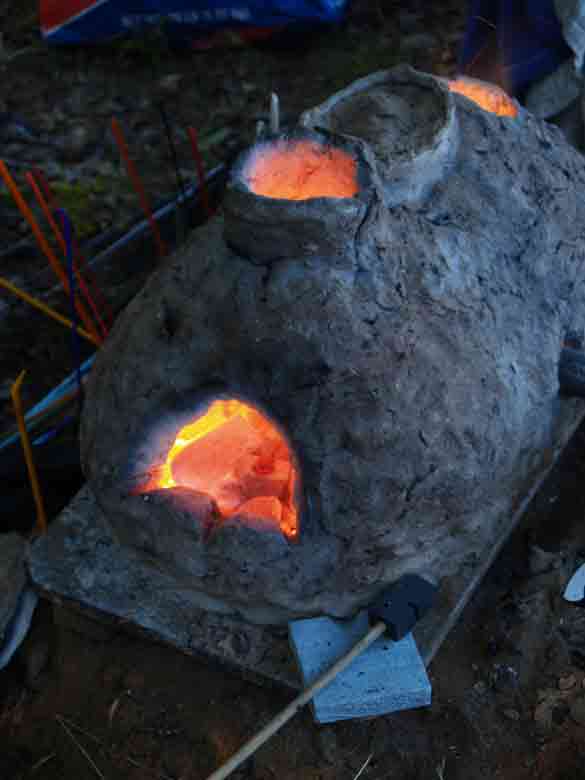...I am currently a student ... and am taking an experimental archeaology class where we intend to attempt a smelt similar to yours. ... I am however, having trouble finding an ore source for our experiment. Can you suggest any suppliers?
You are stuck on the basic problem that all of us working with experimental iron smelting have - where do we get some ore? Although iron is one of the most common elements on the earth's surface, a good workable iron ore body can be hard to find. This problem also defined historic iron smelting sites, which are almost always situated at the location of the ore.
The physical dynamics of the kind of small scale direct iron bloomeries that are seen in Early Medieval archaeology require an iron ore body with an iron oxide (Fe2O3) content of at least 60 %, or about 40 - 45 % Fe. Any lower than that, and the likelihood of producing a viable bloom quickly drops to zero. (This problem of acquiring rich enough ore is what I observed as the major difficulty experienced by the Danish teams.) This is compounded by the fact that modern commercially mined ores are often closer to 30 % iron content (and thus not workable in this type of furnace.)
The underlaying geography of your region will be key to your ability to find a usable deposit of workable iron ore. Even though the total volumes are small (in the range of 50 - 100 lbs ore per smelt) sometimes getting access can become a problem.
Some useful (?) suggestions:
1) First, try to determine if natural deposits of primary bog iron ore are found in your region. The chemistry and geography (even climate) of your area will suggest if this is even possible. Then there is a lot of hunting to undertake to find a useful deposit. I know from my own poking around in northern Newfoundland (were the conditions for formation are ideal) that finding a working volume of bog ore is almost as much by chance as by intent. One problem here is that modern land clearing and draining most commonly destroy the natural process of bog ore deposit.
2) Sauder and Williams looked at old Colonial era records to find abandoned mines to explore. Since the smelting technologies of Revolutionary period were quite similar to those under consideration, the ore bodies exploited are often of a useful concentration. Old county records of industrial history or mining claims may help here. Of course there is a good chance that these mines were completely cleaned out. Hopefully enough material would remain to supply a couple of experimental smelts. There is a vein of ancient geothite iron ore that runs under most (if not all) the Blue Ridge. Sauder and Williams tap into this seam as their (quite excellent) ore source. The group working out of Colonial Williamsburg have local deposits eroded from this parent body available in their area. I can't comment on how far south this material may be found (remember I'm located in Ontario!)
3) There are a couple of modern substitutes. Again availability and ease of access may vary:
A) Industrial Taconite - These are the pellets prepared at modern mine sites from rock ore deposits. At the mine, the rock is crushed and the iron oxide concentrated to marble sized pieces for shipping (via rail or boat) to steel mills. Often at all the points along the distribution chain there is considerable spillage. Enough ore for a smelt can be sometimes gathered off the ground along rail lines. Obviously you need to be located near a mine, mill or transit lane for this source to be useful. One of the advantages of taconite is that it is very easy to handle, and both roasts and breaks up fairly easily. The chemical content is often known to close detail.
B) Industrial Hematite - This material is used for commercial sand blasting, and is available as a fine grit. Check your local 'Industrial Sand Blasting' company in the yellow pages. The material is distributed (source is Quebec Canada) by Opta Minerals / Virginia Minerals This is an extremely pure and concentrated iron oxide. It does have too fine a particle size, which means some careful control of the smelt process is required. It is also quite inexpensive, at about $20 for a 90 lb bag.
C) Red Iron Oxide / DARC Dirt 1 - Red iron oxide is used for colour in paints, concrete and most importantly by potters. Your best source for this may be your local ceramic supplier. Bags of 'Spanish Red' are again quite inexpensive (also about $20 per 90 lb bag). The material as purchased is too fine to work correctly inside the type of smelter under discussion however.
The solution we have been developing (DARC) is to mix up the powder with an organic binder (flour) and some additional silica (fine white sand). Water is added to create a paste, which is then spread and left to sun dry, then broken up to the desired particle size.
If you piece together the past postings related to DARC Dirt on the blog, you would get a running commentary of our (yet unpublished) work on this analog for primary bog iron ore. (I would ask anyone making use of our data to credit this base level research.)
There is a lot of related information buried inside the various blog entries and through the various articles and reports on the web site. Each ore body has its own quirks, even historically, furnaces were altered off the basic plan to suit the dynamics of a particular ore.






